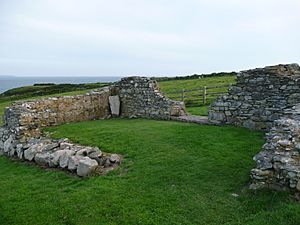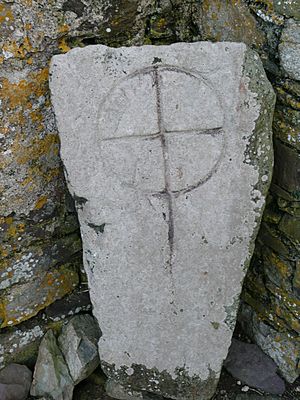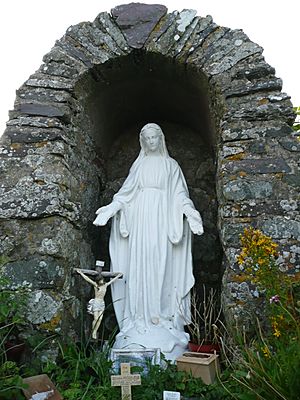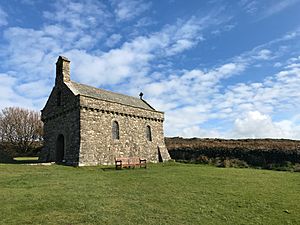Chapel of St Non facts for kids
The Chapel of St Non is a special old building found on the coast near St David's in Pembrokeshire, West Wales. People believe it's the birthplace of St David, who is the patron saint of Wales. This old chapel is unique because it faces north-south, not east-west like most churches. Close by, you'll find a quiet retreat center, a newer chapel, and a holy well. The Welsh heritage group Cadw has looked after this important site since the 1950s.
Contents
History of St Non's Chapel
The old Chapel of St Non is located near the Pembrokeshire Coast Path, a few miles from St David's city. Christian stories say that Saint Non was born around the year 475 AD. She was the daughter of Lord Cynyr Ceinfarfog.
St Non and St David
Saint Non lived as a nun near Whitesands Bay. She had a child, a boy, at Caerfai Bay. This boy grew up to become St David, the patron saint of Wales.
Chapel's Ancient Roots
People think the ruined chapel stands where St Non's house once was. It is believed to be one of the oldest Christian buildings in Wales. In medieval times, many Christian pilgrims visited this chapel. After the Protestant Reformation, people stopped making pilgrimages. The chapel was then used as a house and later as a garden. The site is now a Grade II listed building. The Welsh heritage group Cadw took over its care in the 1950s.
St Non's Cross
Inside the ruined chapel, there is a large stone with a cross carved into a circle. This stone is known as St Non's Cross. It was found in the same field as the chapel. It might have been a grave marker or an altar stone. Experts believe the stone was made between the 7th and 9th centuries. However, there is no strong proof that it was originally from this exact spot.
Ancient Standing Stones
In the field around the chapel, you can see several standing stones. These stones might show that people lived here during the Iron Age. It's possible that the chapel was built inside an old circle of these standing stones, which might have been used for pagan ceremonies.
The Healing Holy Well
A holy well is located very close to the chapel. People believed this well had special healing powers. Even today, visitors often throw coins into the well for good luck. Old records from 1717 mention that the well had a stone roof and benches. They also say that some people still visited the well, especially on St Non's Day (March 2nd). They would offer small items like pins and pebbles.
Well's Popularity and Restoration
Reports from 1811 state that the well was incredibly famous. Many people still visited it for various health problems. It was thought to be especially good for eye issues. The Catholic Church restored the well in 1951. They also built a shrine nearby using stones from other old ruins. The water from this well was even used by Pope Benedict XVI during his visit to Britain.
Modern Chapel of Our Lady and St Non
A newer chapel was built near the old ruins in 1934. Cecil Morgan-Griffiths, a lawyer from Carmarthen, built it. He used stones from other ruined chapels nearby. He had built a house overlooking the sea, which is now a retreat. Since the nearest Catholic church was far away, he decided to build a new one on this historic site.
Features of the Modern Chapel
This new chapel is the most westerly church in Wales. It is also one of the smallest, being only 25 feet long and 12 feet wide. It has beautiful stained glass windows. These windows show images of St Non, St David, St Bride, St Brynach, and St Winifred. The holy water font at the door is the only part left from another old chapel. The altar uses a white stone from the altar of St Patrick's Chapel. The window above the altar was made in the style of William Morris. Cecil Morgan-Griffiths passed away the year after the new chapel was finished.
St Non's Retreat
Behind the modern chapel is St Non's Retreat. This place was once owned by the Passionist Fathers, a religious group. It was run by the Sisters of Mercy as a registered charity. The retreat offered a peaceful place for people to relax and think. It also hosted workshops and sessions, from yoga to support for parents who had lost a child.
Current Use of the Retreat
The retreat is now owned by the Roman Catholic Archdiocese of Cardiff-Menevia. It continues to be run as a place for quiet reflection. In early 2024, the retreat was extensively renovated. It reopened in April 2024, ready to welcome visitors again.
See also






